New WiFi equipment from Ruckus Wireless. New: access points, controllers and functionality
Today we want to talk about the latest products of the manufacturer of WiFi equipment Ruckus Wireless , and a lot of them have accumulated over several quarters: 7 access points of the 802.11ac standard, including Wave 2, a new controller and new functionality.
There are a large number of wireless WiFi systems of various manufacturers on the market, representing both minimalistic solutions based on autonomous access points, and centralized solutions with a network controller or cloud solutions with a cloud controller.
In our opinion, Ruckus equipment stands out from the competition with its capabilities, performance and reasonable price. In this article we will give an overview of the model range and the architecture of the networks presented by the manufacturer at the end of last and the beginning of this year.
The Ruckus Wireless system is a hybrid of autonomous and centralized networks of the American manufacturer. As in centralized networks, Ruckus supports inextricable roaming of subscribers, optimization of radio coverage (selection of optimal radio channels and capacities), load balancing and centralized management. Moreover, the ZoneDirector controller is able to authorize users using the built-in user database and an external RADIUS server and perform web authorization.
From autonomous access points, Ruckus uses the ability to locate access points behind a routed network and Internet channels, as well as the ability to locally switch user traffic without sending it through the controller, which allows you to install the controller remotely and control currents through a small capacity channel. Each point can be configured as a router, raise an L2TP connection and implement NAT. Thus, it becomes possible to place access points remotely and connect them to various Internet channels.
Here is a description of the updated range of Ruckus Wireless. It includes access points for both outdoor and indoor use of the ZoneFlex product line.
Internal access points
The new generation of ZoneFlex R-Series internal access points is the R300, R 500, R600, R700, and R710.
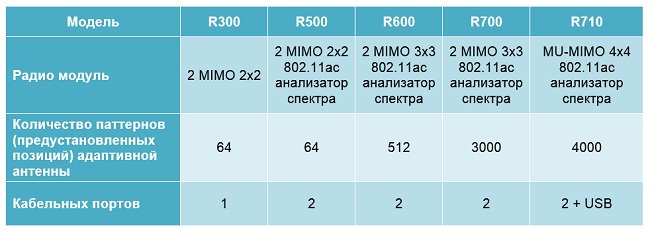
Let's consider the most interesting functions of new devices in more detail.
One of the important functions that should be mentioned, given the state of the ether, is a spectrum analyzer. All new points, except R300, are equipped with an ether analyzer and use it when choosing a frequency rating. It is also possible to connect to a remote access point and transfer it to analyzer mode to study the current situation on the air.
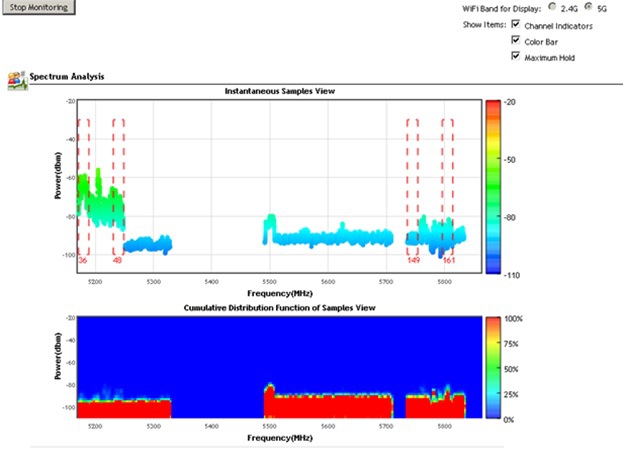
Spectrum analyzer built into Ruckus access points
Technical specifications of the points in more detail.
R300
ZoneFlex R300 - the youngest model of the new generation, which replaced the ZoneFlex 7363.
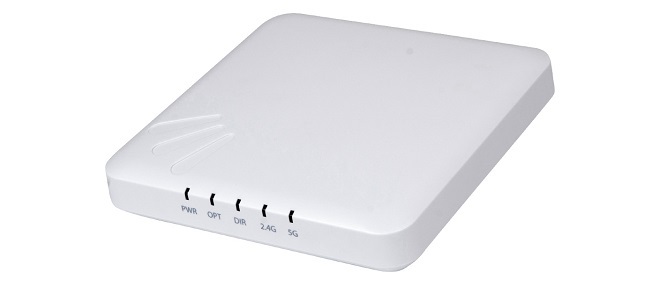
Appearance of ZoneFlex R300. The point is very compact - dimensions 13 x 13 x 2.8 cm.

Antenna system of the ZoneFlex R300 access point.
Two radio modules 802.11n, an adaptive antenna and small sizes make the R300 a convenient solution for networks with a low density of subscribers (cafes, hotels). However, we, of course, are more interested in new access points with support for 802.11ac, and there are many of them.
R500 and R600
ZoneFlex R500 and R600 - use boards and radio modules similar to the R700, but have a less developed antenna system. Actually, the R600 differs from the R500 in a more complex antenna system and the number of MIMO streams. These points are positioned as mid-range solutions.
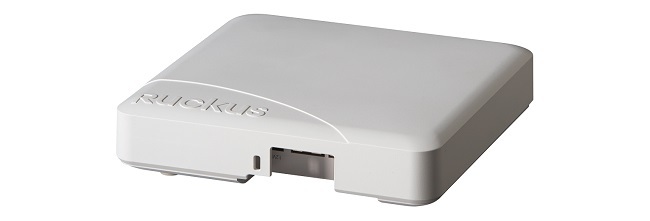
ZoneFlex R500 / R600 Access Points Appearance ZoneFlex R500

Antenna System (left) and R600 (Right)
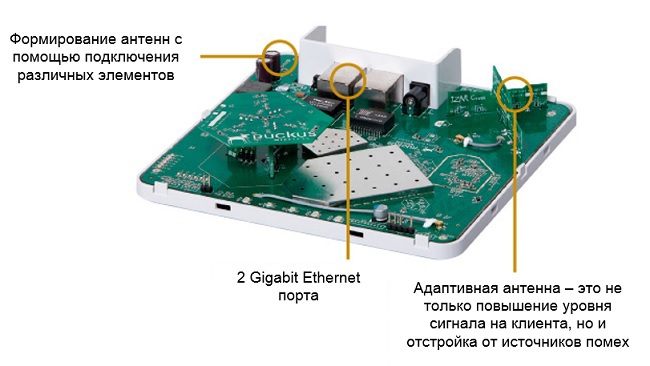
By design, the R500 / 600 points resemble ZoneFlex 7372, but they use more advanced components of the
R700.
ZoneFlex R700 is a high-performance access point with support for 3 channels MIMO 802.11ac. The point offers support for new technologies, such as spectral analysis of the air and optimization of the service of smartphones and tablets using a combination of antenna signals of different polarization.
The R700 provides usable performance over 650 Mbps in the 5 GHz band powered by a standard 802.3af source.

ZoneFlex R700 3-channel antenna system
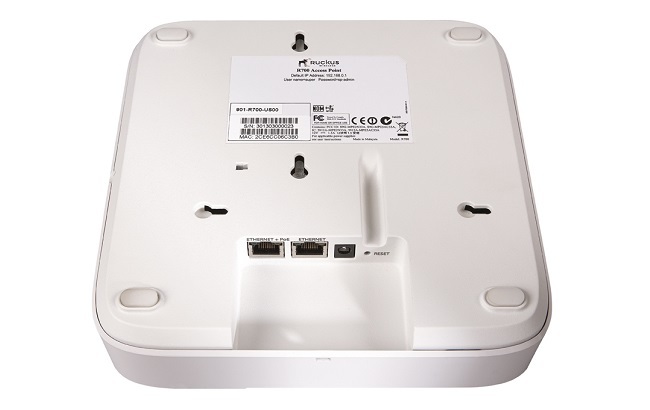
View from the side of R710 connectors

ZoneFlex R710 - the latest Ruckus development, the first access point supporting Wave 2 of the 802.11ac standard with a bandwidth of 800 Mbit / s in the 2.4 GHz frequency band plus 1733 Mbit / s in the 5 GHz band, for a total of 2.5 access points Gbps In addition to speed, Multi-User MIMO technology (abbreviated MU-MIMO) is supported, that is, the R710 can serve several subscribers simultaneously. Namely, the device provides a dedicated channel with full bandwidth to three clients at once. The effect of spatial diversity of the signal and reuse of radio frequency resources is used. As a result, the efficiency of the use of ether, productivity and accessibility of the environment are increased. As you can see, even the form factor of the equipment has changed.
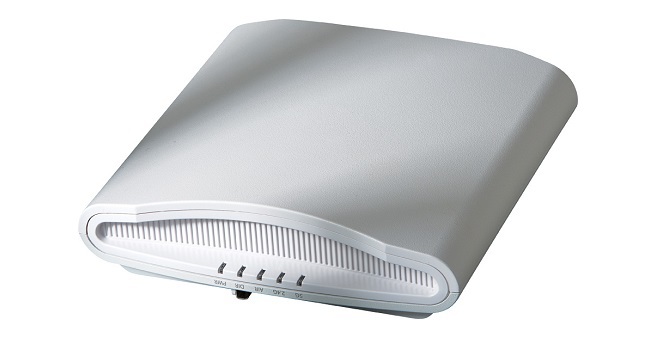
ZoneFlex R710 Access Point Appearance
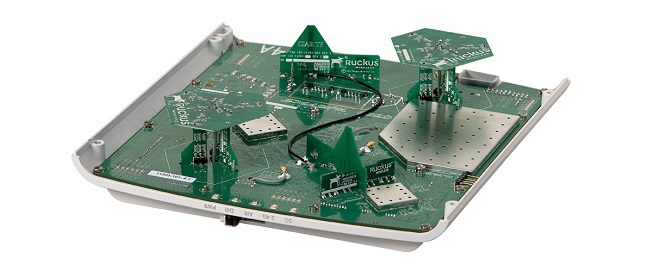
ZoneFlex R710 Antenna System
Outdoor access points
Three new all-weather 802.11ac access points appeared - ZoneFlex T300, T301s and T301n.

Earlier, when building outdoor networks, we used the ZoneFlex 7762 access point, an all-weather solution that has proven itself in many installations.

The appearance of the ZoneFlex 7762 access point and the antenna system, which conquered the market at one time,
But the point is probably quite dimensional today and does not have 802.11ac support. Therefore, the new T300 series - the logical continuation of 7762, now with support for the AC standard.
Unlike the 7762S, all T300 / 301 models have built-in adaptive antennas of both frequency ranges, while to use 5 GHz in the 7762S, an additional antenna had to be used.

Appearance of ZoneFlex T300 (left) and T301 (right)
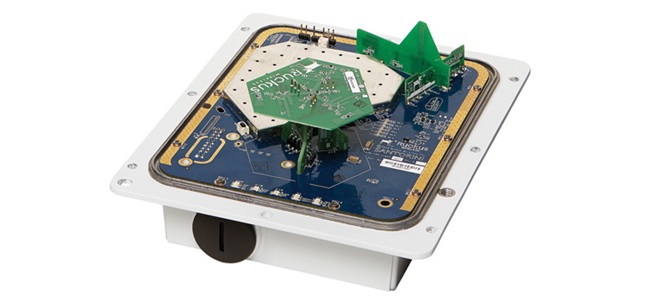
Antenna system ZoneFlex T300
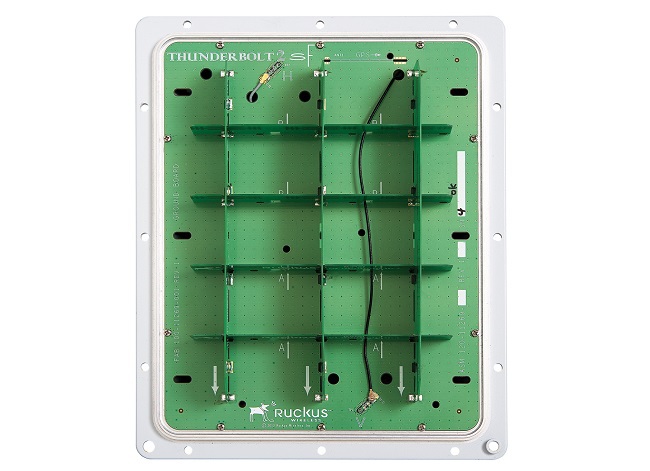
Antenna system ZoneFlex T301n
It must be remembered that all the advantages of 802.11ac technology are realized only in the 5 GHz band, which is subject to licensing. However, the smaller size than the 7762 makes the T300 / 301 series very interesting when using 2.4 GHz networks. Note that all Ruckus access points can be used both in standalone mode, that is, by themselves, and in the version with a control controller.
WiFi Network Controllers
The line of Ruckus controllers this year has been significantly updated. We would even say it was updated and split: now, in addition to the classic ZoneDirector lineup, which includes the new 1200 model, a new SmartZone carrier line has appeared.
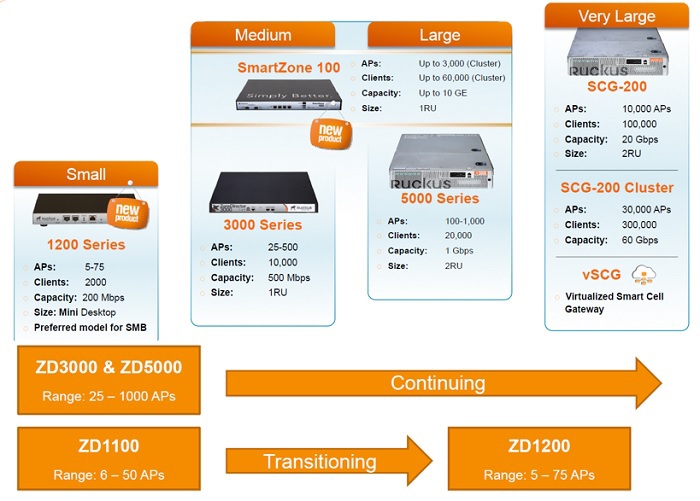
The Ruckus family of controllers
However, the differences between ZoneDirector and SCG are so great that we will publish a separate article on the new SCG line. Therefore, let me introduce the ZoneDirector 1200 network controller for now, and then make a small announcement of the SmartZone 100 model.
Table of the main parameters of the controllers
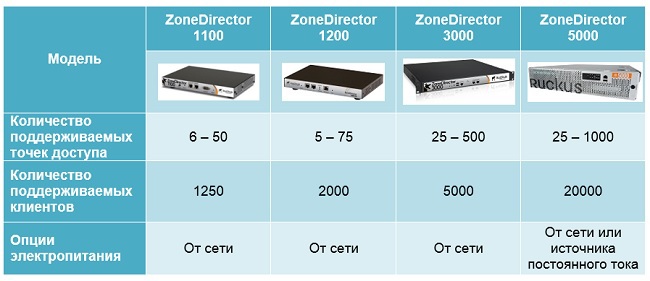
From the point of view of the 1200 model series, the model becomes closer to the 3000 series and allows you to build quite large WiFi networks.

Compare the ZoneDirector controllers of the thousandth series and note the following improvement of 1200 parameters over 1100:
1. One and a half times more capacity in the number of supported access points
2. One and a half times more capacity in terms of the number of connections
3. Possibility of licensing in increments of one access point We
also list the functionality implemented by the Ruckus controller. When using the controller, the network acquires additional features:
• Centralized management
• Seamless roaming
• Self-organizing MESH networks
• Load balancing
• Centralized radio planning
• Guest authorization of clients
• Guest authorization of clients with data protection
• 3G-offload, including HotSpot 2.0
SmartZone 100
SmartZone 100 allows you to administer WiFi networks of operators and enterprises. The device is capable of serving 1024 access points, 25,000 concurrent sessions and 2048 VLANs. Moreover, you can combine up to four devices in a cluster (3 + 1 for backup) and achieve impressive network management: 3 thousand access points, 60 thousand simultaneous sessions and 6 thousand VLANs.

New software
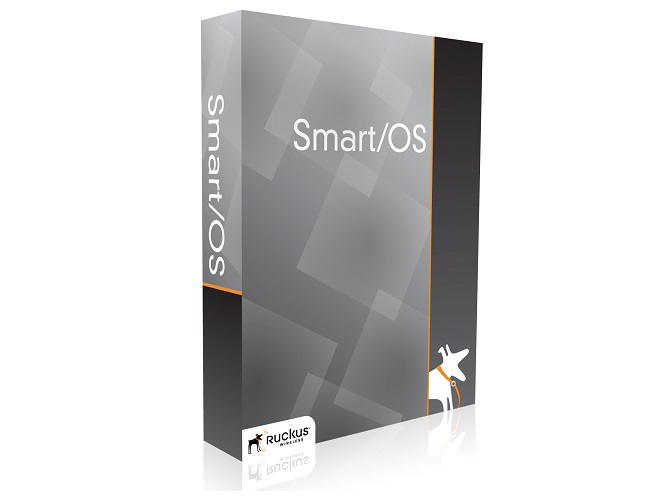
More recently, Ruckus controller software has been updated to version 9.9, and now we can talk about version 9.10. What new features does this software promise us?
Firstly, this is a user’s self-registration. If earlier during web authorization it was necessary to give the client a password for the reception, or set up an SMS gateway when registering by mobile phone number, now we can use the link to the inviting person. When registering on the page, the user indicates his data, who invited him, and this information comes by e-mail to the inviting person who can confirm the guest’s access.
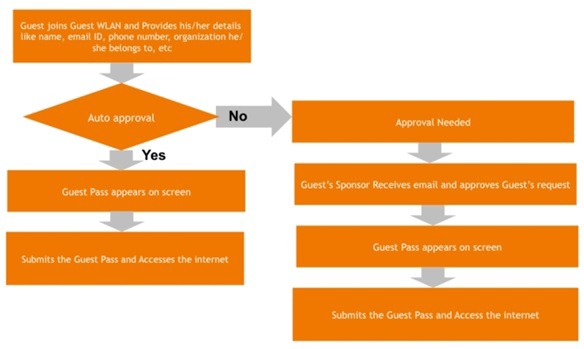
The self-registration scheme using the inviting person The
second important news we would call the appearance in the new software for access points of the AC standard MESH technology. It was strange that the new access points lacked the functionality of older models. Yes, and the capacity of 802.11ac is definitely conducive to such an implementation.

The manufacturer emphasizes the presence of MESH in 802.11ac solutions.
Although technology support is available at all new points, it must be remembered that it is possible to legally use the 5 GHz band only indoors.
However, there are certain features of the use of new software that need to be mentioned. Firstly, the 1100 series controller has some limitations, although there is 9.10 software for it, it does not support H500 access points. Secondly, not all devices will be able to install new software. If earlier Ruckus recommended acquiring support on devices, and only warned in the menu about its absence, now it will not work to install software 9.10 that is deprived of support on the controller.
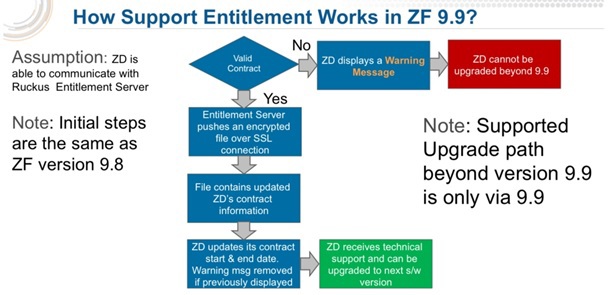
Software Update Scheme 9.10
Conclusions
This year, Ruckus has updated almost the entire line of its equipment. Now we can simultaneously get the advantage of adaptive antennas and support for the standard 802.11ac, which is implemented in access points R500 / 600/700/710. The all-weather points of the T300 / 301 series now support the 802.11ac standard, have smaller dimensions than the ZoneFlex 7762 and are significantly lower in price. The new ZoneDirector 1200 model controller is significantly superior to the 1100 model and now the border of small WiFi networks has moved up.


There are a large number of wireless WiFi systems of various manufacturers on the market, representing both minimalistic solutions based on autonomous access points, and centralized solutions with a network controller or cloud solutions with a cloud controller.
In our opinion, Ruckus equipment stands out from the competition with its capabilities, performance and reasonable price. In this article we will give an overview of the model range and the architecture of the networks presented by the manufacturer at the end of last and the beginning of this year.
The Ruckus Wireless system is a hybrid of autonomous and centralized networks of the American manufacturer. As in centralized networks, Ruckus supports inextricable roaming of subscribers, optimization of radio coverage (selection of optimal radio channels and capacities), load balancing and centralized management. Moreover, the ZoneDirector controller is able to authorize users using the built-in user database and an external RADIUS server and perform web authorization.
From autonomous access points, Ruckus uses the ability to locate access points behind a routed network and Internet channels, as well as the ability to locally switch user traffic without sending it through the controller, which allows you to install the controller remotely and control currents through a small capacity channel. Each point can be configured as a router, raise an L2TP connection and implement NAT. Thus, it becomes possible to place access points remotely and connect them to various Internet channels.
Here is a description of the updated range of Ruckus Wireless. It includes access points for both outdoor and indoor use of the ZoneFlex product line.
Internal access points
The new generation of ZoneFlex R-Series internal access points is the R300, R 500, R600, R700, and R710.

Let's consider the most interesting functions of new devices in more detail.
One of the important functions that should be mentioned, given the state of the ether, is a spectrum analyzer. All new points, except R300, are equipped with an ether analyzer and use it when choosing a frequency rating. It is also possible to connect to a remote access point and transfer it to analyzer mode to study the current situation on the air.

Spectrum analyzer built into Ruckus access points
Technical specifications of the points in more detail.
R300
ZoneFlex R300 - the youngest model of the new generation, which replaced the ZoneFlex 7363.

Appearance of ZoneFlex R300. The point is very compact - dimensions 13 x 13 x 2.8 cm.

Antenna system of the ZoneFlex R300 access point.
Two radio modules 802.11n, an adaptive antenna and small sizes make the R300 a convenient solution for networks with a low density of subscribers (cafes, hotels). However, we, of course, are more interested in new access points with support for 802.11ac, and there are many of them.
R500 and R600
ZoneFlex R500 and R600 - use boards and radio modules similar to the R700, but have a less developed antenna system. Actually, the R600 differs from the R500 in a more complex antenna system and the number of MIMO streams. These points are positioned as mid-range solutions.

ZoneFlex R500 / R600 Access Points Appearance ZoneFlex R500

Antenna System (left) and R600 (Right)

By design, the R500 / 600 points resemble ZoneFlex 7372, but they use more advanced components of the
R700.
ZoneFlex R700 is a high-performance access point with support for 3 channels MIMO 802.11ac. The point offers support for new technologies, such as spectral analysis of the air and optimization of the service of smartphones and tablets using a combination of antenna signals of different polarization.
The R700 provides usable performance over 650 Mbps in the 5 GHz band powered by a standard 802.3af source.

ZoneFlex R700 3-channel antenna system

View from the side of R710 connectors

ZoneFlex R710 - the latest Ruckus development, the first access point supporting Wave 2 of the 802.11ac standard with a bandwidth of 800 Mbit / s in the 2.4 GHz frequency band plus 1733 Mbit / s in the 5 GHz band, for a total of 2.5 access points Gbps In addition to speed, Multi-User MIMO technology (abbreviated MU-MIMO) is supported, that is, the R710 can serve several subscribers simultaneously. Namely, the device provides a dedicated channel with full bandwidth to three clients at once. The effect of spatial diversity of the signal and reuse of radio frequency resources is used. As a result, the efficiency of the use of ether, productivity and accessibility of the environment are increased. As you can see, even the form factor of the equipment has changed.

ZoneFlex R710 Access Point Appearance

ZoneFlex R710 Antenna System
Outdoor access points
Three new all-weather 802.11ac access points appeared - ZoneFlex T300, T301s and T301n.

Earlier, when building outdoor networks, we used the ZoneFlex 7762 access point, an all-weather solution that has proven itself in many installations.

The appearance of the ZoneFlex 7762 access point and the antenna system, which conquered the market at one time,
But the point is probably quite dimensional today and does not have 802.11ac support. Therefore, the new T300 series - the logical continuation of 7762, now with support for the AC standard.
Unlike the 7762S, all T300 / 301 models have built-in adaptive antennas of both frequency ranges, while to use 5 GHz in the 7762S, an additional antenna had to be used.

Appearance of ZoneFlex T300 (left) and T301 (right)

Antenna system ZoneFlex T300

Antenna system ZoneFlex T301n
It must be remembered that all the advantages of 802.11ac technology are realized only in the 5 GHz band, which is subject to licensing. However, the smaller size than the 7762 makes the T300 / 301 series very interesting when using 2.4 GHz networks. Note that all Ruckus access points can be used both in standalone mode, that is, by themselves, and in the version with a control controller.
WiFi Network Controllers
The line of Ruckus controllers this year has been significantly updated. We would even say it was updated and split: now, in addition to the classic ZoneDirector lineup, which includes the new 1200 model, a new SmartZone carrier line has appeared.

The Ruckus family of controllers
However, the differences between ZoneDirector and SCG are so great that we will publish a separate article on the new SCG line. Therefore, let me introduce the ZoneDirector 1200 network controller for now, and then make a small announcement of the SmartZone 100 model.
Table of the main parameters of the controllers

From the point of view of the 1200 model series, the model becomes closer to the 3000 series and allows you to build quite large WiFi networks.

Compare the ZoneDirector controllers of the thousandth series and note the following improvement of 1200 parameters over 1100:
1. One and a half times more capacity in the number of supported access points
2. One and a half times more capacity in terms of the number of connections
3. Possibility of licensing in increments of one access point We
also list the functionality implemented by the Ruckus controller. When using the controller, the network acquires additional features:
• Centralized management
• Seamless roaming
• Self-organizing MESH networks
• Load balancing
• Centralized radio planning
• Guest authorization of clients
• Guest authorization of clients with data protection
• 3G-offload, including HotSpot 2.0
SmartZone 100
SmartZone 100 allows you to administer WiFi networks of operators and enterprises. The device is capable of serving 1024 access points, 25,000 concurrent sessions and 2048 VLANs. Moreover, you can combine up to four devices in a cluster (3 + 1 for backup) and achieve impressive network management: 3 thousand access points, 60 thousand simultaneous sessions and 6 thousand VLANs.

New software

More recently, Ruckus controller software has been updated to version 9.9, and now we can talk about version 9.10. What new features does this software promise us?
Firstly, this is a user’s self-registration. If earlier during web authorization it was necessary to give the client a password for the reception, or set up an SMS gateway when registering by mobile phone number, now we can use the link to the inviting person. When registering on the page, the user indicates his data, who invited him, and this information comes by e-mail to the inviting person who can confirm the guest’s access.

The self-registration scheme using the inviting person The
second important news we would call the appearance in the new software for access points of the AC standard MESH technology. It was strange that the new access points lacked the functionality of older models. Yes, and the capacity of 802.11ac is definitely conducive to such an implementation.

The manufacturer emphasizes the presence of MESH in 802.11ac solutions.
Although technology support is available at all new points, it must be remembered that it is possible to legally use the 5 GHz band only indoors.
However, there are certain features of the use of new software that need to be mentioned. Firstly, the 1100 series controller has some limitations, although there is 9.10 software for it, it does not support H500 access points. Secondly, not all devices will be able to install new software. If earlier Ruckus recommended acquiring support on devices, and only warned in the menu about its absence, now it will not work to install software 9.10 that is deprived of support on the controller.

Software Update Scheme 9.10
Conclusions
This year, Ruckus has updated almost the entire line of its equipment. Now we can simultaneously get the advantage of adaptive antennas and support for the standard 802.11ac, which is implemented in access points R500 / 600/700/710. The all-weather points of the T300 / 301 series now support the 802.11ac standard, have smaller dimensions than the ZoneFlex 7762 and are significantly lower in price. The new ZoneDirector 1200 model controller is significantly superior to the 1100 model and now the border of small WiFi networks has moved up.

